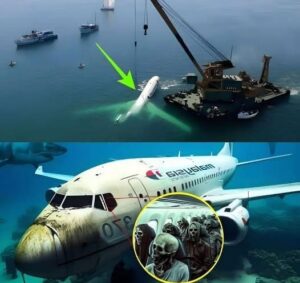Inside the Final Moments of Malaysia Airlines Flight MH370: A Decade of Mystery, Timeline of Events, and the Latest Search Efforts

More than eleven years have passed since Malaysia Airlines Flight MH370 vanished without a trace, and yet the world remains captivated—and haunted—by its disappearance. The Boeing 777 was scheduled for a routine international flight from Kuala Lumpur, Malaysia, to Beijing, China, on March 8, 2014. It never reached its destination. The aircraft, carrying 239 people, seemed to disappear from the face of the Earth, triggering one of the most baffling and enduring aviation mysteries in history.
Now, after more than a decade of dead ends, fragments, and theories ranging from technical failure to deliberate sabotage, a new chapter in the search has begun. Advanced underwater mapping and refined satellite analysis have prompted authorities and independent researchers to return to the ocean in hopes of solving the riddle once and for all.
Here is a comprehensive look into the final known movements of Flight MH370, what investigators have uncovered so far, and why the search for answers is far from over.
The Final Flight: A Timeline of Events
12:42 a.m. – Departure from Kuala Lumpur International Airport
Malaysia Airlines Flight MH370 departs on schedule, lifting off from Runway 32R with 227 passengers and 12 crew members on board. The aircraft, a Boeing 777-200ER, had been cleared for a nighttime flight to Beijing Capital International Airport. The weather was calm, and all pre-flight checks were reported as normal.
1:01 a.m. – Reaches Cruising Altitude
The flight ascends to its planned cruising altitude of 35,000 feet. Communication between the aircraft and air traffic control continues normally for several minutes. Nothing appears out of the ordinary.
1:19 a.m. – Final Voice Transmission
The last known verbal communication from the cockpit comes at 1:19 a.m., when a voice—believed to be that of Captain Zaharie Ahmad Shah—says: “Good night, Malaysian three-seven-zero.” This message is delivered just as the flight transitions from Malaysian airspace into Vietnamese airspace. It would be the last time anyone would hear from MH370.
1:21 a.m. – Transponder Goes Dark
Two minutes after the final voice communication, the plane’s transponder, which broadcasts location and altitude to air traffic controllers, is shut off. At this point, civilian radar loses track of the aircraft, though military radar would later show it making an unexpected turn westward, back across the Malaysian Peninsula.
1:30–2:15 a.m. – Mysterious Turn and Course Change
Military radar tracked MH370 as it deviated sharply from its flight path, flying over the Strait of Malacca. It then turned southward into the remote southern Indian Ocean. No distress signal was ever sent, and no explanation for the change in course was provided.
2:22 a.m. – Last Radar Contact
The last known radar detection occurred near the northern tip of Sumatra. After this, the aircraft disappeared from all known tracking systems, with no further voice, transponder, or radar data available.

The Silent Hours: Inmarsat Pings and the ‘Seventh Arc’
Though no radar or radio communications followed, MH370’s satellite communication system remained active. Over the next six hours, it continued to exchange hourly “handshake” signals—also known as “pings”—with an Inmarsat satellite. These pings allowed investigators to map out a possible arc of the aircraft’s trajectory across the southern Indian Ocean.
The final handshake occurred at 8:19 a.m., indicating the aircraft was still airborne nearly seven hours after losing contact. That ping, followed by complete silence, is believed to be when the aircraft either ran out of fuel or suffered a catastrophic failure.
The Search Efforts: From Hope to Frustration to Hope Again
The search for MH370 began almost immediately after it disappeared but soon became one of the most expensive and complex search operations in aviation history. Despite massive multinational efforts involving ships, aircraft, and deep-sea sonar systems, the primary wreckage has never been located.
Several pieces of debris believed to be from MH370 have since washed up on beaches around the Indian Ocean—on islands like Réunion, in Mozambique, and Madagascar. These fragments helped confirm that the aircraft did crash into the ocean, but offered few clues about the exact location.
From 2014 to 2018, two major search efforts were conducted—one led by the Australian government and another by the private U.S. company Ocean Infinity. Both missions mapped large areas of the seafloor but ultimately failed to locate the main fuselage or the black boxes.

Why the Search Has Resumed in 2025
In early 2025, new satellite data, refined ocean drift models, and reanalysis of existing radar and Inmarsat data have given fresh momentum to the hunt. Ocean Infinity, which had previously participated in the 2018 effort, has launched a new search mission using autonomous underwater vehicles equipped with cutting-edge sonar and imaging tools. Experts believe that the plane may have gone down just outside the originally searched areas, possibly within a narrower corridor along what’s known as the “Seventh Arc.”
The renewed search has been welcomed by families of the victims, many of whom have spent the last decade demanding answers and closure. “We just want to know what happened. We want something to hold onto,” said one family member during a recent memorial in Kuala Lumpur.
Theories and Speculation: What Could Have Happened?
Over the years, numerous theories have circulated—ranging from hijacking and pilot suicide to electrical failure or hypoxia (lack of oxygen due to cabin depressurization). While some experts support the idea of a deliberate course change by someone in the cockpit, others argue the evidence points to a mechanical failure or incapacitation scenario.
No official cause has been determined, and until the plane’s flight data recorders are recovered, many of these theories will remain speculative.

The Legacy of MH370
The disappearance of Flight MH370 has profoundly impacted global aviation. It exposed gaps in radar coverage, real-time aircraft tracking, and coordination between international agencies. Since then, regulators have pushed for mandatory aircraft tracking systems and greater transparency during emergencies.
For the families and the world at large, the mystery of MH370 remains deeply emotional. As one aviation expert recently put it, “This is not just about an airplane. It’s about 239 people who deserve answers, and a global promise that we won’t stop looking until we find the truth.”